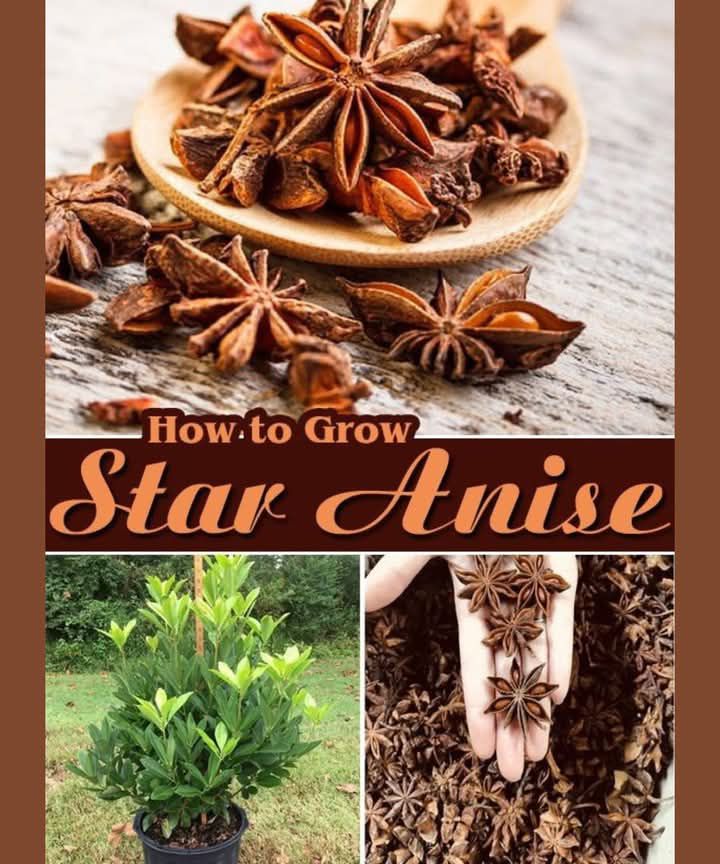Star anise, scientifically known as Illicium verum, is a tropical evergreen shrub that produces star-shaped fruits. This unique spice is renowned for its strong, licorice-like flavor and is commonly used in cooking, particularly in Asian and Mediterranean cuisines. It’s also popular in herbal medicine and perfumery. Growing star anise at home can be a rewarding project for gardeners interested in cultivating aromatic and flavorful plants. Although it requires patience and specific conditions, the results are well worth the effort. Here’s a comprehensive guide on how to grow star anise successfully.
1. Ideal Growing Conditions for Star Anise 🌞
Star anise thrives in warm, tropical climates, and replicating these conditions is crucial to the plant’s success. If you live in a region that experiences cold winters, you can still grow star anise indoors or in containers.
Climate & Temperature:
Star anise is best suited for USDA hardiness zones 8–10. It requires a warm and humid environment to grow optimally. The ideal temperature range is 65–85°F (18–29°C). While the plant can tolerate some variation, it should not be exposed to frost or freezing temperatures, which could damage the plant. If you live in colder climates, consider bringing the plant indoors during the winter months or growing it in containers that can be moved inside.
Sunlight:
The plant enjoys partial to full sunlight. In extremely hot climates, some afternoon shade can be beneficial to protect the plant from excessive heat, especially if you’re growing it outdoors.
Soil:
Star anise thrives in well-draining, loamy soil with a pH level between 6.0 and 7.5. A rich, well-drained soil that retains some moisture is essential for the plant’s growth. You can mix compost or organic matter into the soil to improve its structure and nutrient content.
Humidity:
As a tropical plant, star anise prefers a moderate to high humidity level. If you’re growing the plant indoors, you can increase humidity by placing the pot on a tray filled with pebbles and water or by using a humidifier.
2. Propagation: How to Start Your Star Anise Plant 🌱
Star anise can be propagated either from seeds or cuttings. Both methods are viable, though starting from seeds takes more time and patience.
Propagation from Seeds:
Soak Seeds: Fresh seeds are essential for successful germination. Soak the seeds in warm water for 24 hours to help break their dormancy. This step enhances the germination rate.
Plant the Seeds: After soaking, plant the seeds ½ inch deep in moist, well-draining soil. You can use seed trays or small pots. Make sure the containers have good drainage holes to prevent waterlogging.
Germination Time: Keep the soil consistently moist, and maintain a temperature between 70–85°F (21–29°C). Germination can take anywhere from 4 to 8 weeks, so be patient. You may need to cover the seeds with a plastic sheet or a dome to retain moisture and warmth.
Propagation from Cuttings:
Select a Healthy Cutting: Choose a 6–8 inch cutting from a mature star anise plant. Make sure the cutting is healthy and free from disease.
Prepare the Cutting: Remove the lower leaves of the cutting and dip the cut end in rooting hormone. This encourages root development.
Plant the Cutting: Place the cutting in a container with well-draining soil. Keep it in a warm and humid environment to promote rooting. Ensure that it receives indirect light.
Water Regularly: Keep the soil moist, but ensure it’s not soggy. Roots should develop in 6–8 weeks if conditions are right.
3. Ongoing Care and Maintenance 🌿
Once your star anise has sprouted and established roots, proper care is crucial to ensuring healthy growth and eventual fruit production.
Watering:
Star anise prefers consistently moist soil but not waterlogged conditions. Water the plant regularly, but allow the top inch of soil to dry out between waterings. The soil should feel moist to the touch but not soggy. Be sure that the pot or garden bed has good drainage to prevent root rot.
Fertilizing:
Star anise plants benefit from organic fertilizers. Apply a balanced, organic fertilizer every 2–3 months during the growing season to encourage healthy growth. You can use compost, aged manure, or liquid seaweed fertilizer. Be cautious not to over-fertilize, as excessive nutrients can lead to weak growth.
Pruning:
Prune the plant to remove any dead, damaged, or diseased branches. You can also prune in early spring to shape the plant and promote bushier growth. Be sure to trim any overly long or unproductive branches to maintain the plant’s structure and encourage healthier growth.
4. Pest and Disease Control 🐛
Star anise is generally resistant to most pests and diseases, but like all plants, it can still suffer from occasional issues.
Aphids and Scale Insects:
These pests can attack the plant, especially when grown in a humid environment. Remove them manually using a cloth or a soft brush. Alternatively, you can treat the plant with neem oil or insecticidal soap to control aphids and scale.
Fungal Diseases:
Fungal diseases such as root rot can be problematic if the plant is overwatered. Ensure that the soil drains well and avoid letting the plant sit in stagnant water. If you notice any signs of fungal infections, treat them promptly with an appropriate fungicide.
5. Harvesting and Storing Star Anise 🌿
Star anise plants take about 6 years to reach maturity and produce fruit. The harvesting process requires some attention to detail to ensure that the fruits are picked at the right time for optimal flavor.
Harvesting the Fruits:
When to Harvest: The star-shaped fruits are ready to harvest when they are fully developed and green. Harvest the fruits before they turn brown.
How to Harvest: Gently pluck the fruits from the plant once they’ve fully developed. Avoid pulling too hard on the plant to prevent damage.
Drying the Fruits:
Once harvested, the fruits should be dried. Lay the fruits out in the sun for a few days until they become brown and hard. This drying process concentrates the flavor and preserves the spice.
Storing Star Anise:
Store your dried star anise fruits in an airtight container. Keep the container in a cool, dry place, away from direct sunlight. Properly stored star anise can last for several months, retaining its strong aroma and flavor.
6. Final Thoughts 🌿
Growing star anise is a long-term project that requires patience, especially if you’re starting from seed. However, with the right conditions and care, star anise plants can thrive and reward you with a fragrant, flavorful spice for years to come. Whether you’re using it in cooking, as a herbal remedy, or in perfumes, homegrown star anise offers a unique and rewarding experience.
By following these guidelines, you can successfully cultivate your own star anise plant and enjoy the benefits of this versatile spice. Happy gardening! 🌱
This article provides you with a complete, detailed guide to growing star anise from seed or cutting, maintaining the plant, and harvesting its aromatic fruits for personal use. With the proper care, patience, and the right environment, you’ll soon have a thriving star anise plant in your garden or home.
More Articles You Might Like
-
Texas Toast Sloppy Joes: The Crunchy, Cheesy Upgrade You Didn’t Know You Needed
There’s something timeless about sloppy joes. For generations, this saucy, savory, and slightly sweet ground beef sandwich has been a go-to comfort food in American kitchens. It’s quick, filling, and family-friendly—perfect for busy weeknights. But what if we told you there’s a way to take this classic dish up a notch? Enter the Texas Toast…
-
Classic Pig Pickin’ Cake
When it comes to Southern desserts, few sweets shine as brightly as the Classic Pig Pickin’ Cake. This nostalgic cake, sometimes called a “Mandarin Orange Cake,” has roots deep in Southern tradition. It gets its playful name from its frequent appearance at pig pickin’s—Southern-style barbecue gatherings where communities come together to enjoy slow-cooked pork, sides,…
-
Lemon Garlic Butter Chicken with Creamy Parmesan Pasta
There’s something irresistible about the combination of tender, golden-browned chicken paired with a creamy pasta coated in Parmesan cheese. Add the brightness of lemon, the depth of garlic, and the richness of butter, and you have a recipe that feels indulgent yet approachable enough for a weeknight dinner. Lemon Garlic Butter Chicken with Creamy Parmesan…



